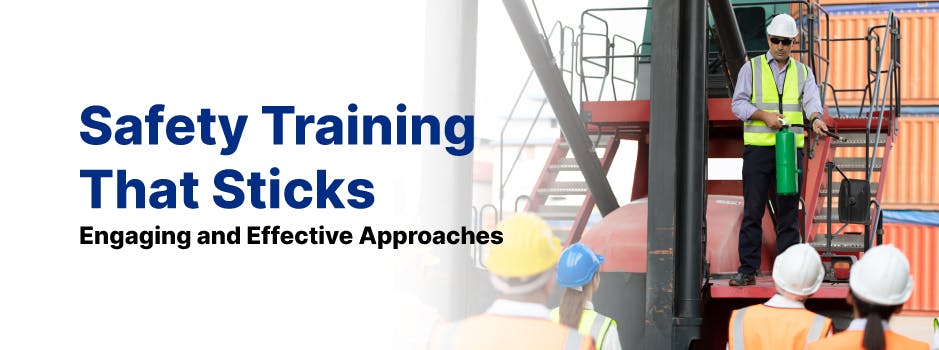Introduction
Safety training is a critical component of any workplace safety program. Ensuring that employees understand and apply safety procedures is essential for reducing workplace accidents, enhancing productivity, and fostering a strong safety culture. However, traditional safety training methods can sometimes be dull and ineffective, leading to poor retention and limited impact. In this comprehensive guide, we will discuss the importance of engaging and effective safety training, explore various approaches and techniques that can help safety training "stick," and provide practical tips for designing safety training programs that are both informative and memorable.
The Importance of Engaging and Effective Safety Training
Why Engaging Safety Training Matters
Engaging safety training is important for several reasons, including:
- Enhancing employee retention of safety information, leading to more effective application in the workplace
- Improving employee participation and interest in safety training, resulting in a more positive and proactive safety culture
- Reducing workplace accidents and injuries by ensuring that employees understand and follow safety procedures
- Meeting regulatory requirements for safety training, while also demonstrating an organization's commitment to employee safety and well-being
The Impact of Effective Safety Training on Workplace Safety
Effective safety training can have a significant impact on workplace safety by:
- Empowering employees with the knowledge and skills to identify and control hazards
- Encouraging employees to take responsibility for their own safety and the safety of others
- Improving communication and teamwork around safety issues
- Enhancing the overall safety culture within an organization, leading to a more proactive approach to hazard identification and prevention
Engaging and Effective Safety Training Approaches
Interactive Learning
Interactive learning involves active participation from employees, helping them to retain information more effectively. Some examples of interactive learning techniques include:
- Group discussions and brainstorming sessions
- Role-playing exercises or simulations
- Hands-on demonstrations or practice sessions
- Interactive quizzes or games
Storytelling and Real-Life Examples
Incorporating storytelling and real-life examples into safety training can help to make the content more relatable and memorable for employees. Consider using:
- Case studies or incident reports that illustrate the consequences of not following safety procedures
- Personal anecdotes or experiences shared by trainers or fellow employees
- Video testimonials or interviews with individuals who have been affected by workplace accidents
Microlearning
Microlearning involves breaking down safety training into smaller, more digestible segments that can be easily accessed and reviewed as needed. This approach can help to reinforce key concepts and encourage ongoing learning. Examples of microlearning techniques include:
- Short video clips or animations that explain specific safety concepts
- Brief, focused training sessions on a single safety topic
- Infographics or visual aids that summarize important safety information
Gamification
Gamification involves incorporating game-like elements into safety training to make it more engaging and enjoyable for employees. Examples of gamification techniques include:
- Leaderboards or point systems that reward employees for their participation in safety training activities
- Interactive quizzes or games that test employees' knowledge of safety concepts
- Virtual reality (VR) or augmented reality (AR) simulations that allow employees to practice safety procedures in a realistic, immersive environment
Practical Tips for Designing Engaging and Effective Safety Training Programs
Customize Training to Your Workplace
Tailor safety training programs to your specific workplace by addressing the unique hazards and challenges that employees may encounter. This can help to ensure that the training is relevant and applicable to their daily tasks and responsibilities.
Encourage Employee Participation and Input
Involve employees in the design and implementation of safety training programs by seeking their input on training topics, formats, and materials. This can help to ensure that the training is engaging and addresses their needs and concerns.
Combine Different Training Approaches
Use a variety of training approaches and techniques to appeal to different learning styles and preferences. Combining different methods, such as interactive learning, storytelling, and microlearning, can help to create a more engaging and comprehensive safety training program.
Regularly Update and Review Training Materials
Keep safety training materials up-to-date and relevant by regularly reviewing and updating them to reflect changes in industry standards, regulations, or workplace practices. This can help to ensure that employees receive the most current and accurate safety information.
Evaluate Training Effectiveness
Assess the effectiveness of safety training programs by measuring their impact on employee knowledge, behaviors, and workplace safety outcomes. This can help to identify areas for improvement and ensure that training programs are achieving their intended goals.
Conclusion
Engaging and effective safety training is essential for creating a safer work environment and reducing workplace accidents. By incorporating a variety of training approaches and techniques, such as interactive learning, storytelling, and gamification, employers can design safety training programs that not only meet regulatory requirements but also foster a strong safety culture and promote long-term employee well-being. With the right strategies in place, safety training can become a powerful tool for empowering employees with the knowledge and skills needed to maintain a safe and healthy workplace.

